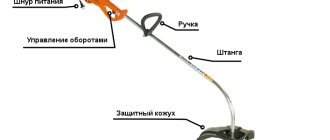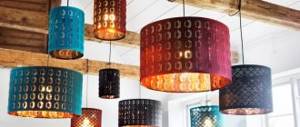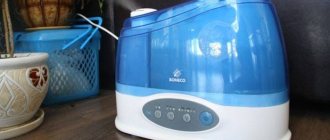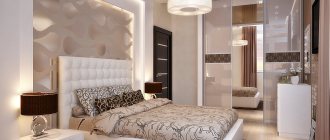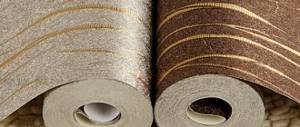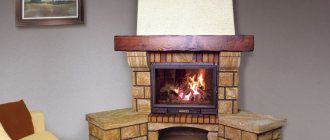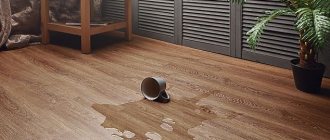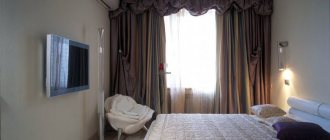Why do you need a dehumidifier?
Before we figure out why we need air dehumidification systems, let’s consider the negative consequences that arise from excess humidity in a room, and these are:
- The appearance of mold . Mold spores are very dangerous to humans. They can penetrate the lungs and provoke the development of allergic and pulmonary diseases.
- Weakening of the immune system. This phenomenon entails an increase in the incidence of viral infections.
- Decreased oxygen supply to cells. Moist, heavy air cannot effectively saturate the blood with oxygen. This entails oxygen starvation of tissues and the development of pulmonary diseases.
- With high humidity, both low and high temperatures are more difficult to tolerate . This creates additional stress on the blood vessels and heart.
This is just a small list of the effects of high humidity on the human body. It is worth noting that humidity poses the greatest danger to children, because their immune system is weak and they are most susceptible to various diseases. Therefore, as soon as you notice an increase in the humidity in the apartment, we immediately dry the air in the room with a dehumidifier or look for ways to dry the air on our own.
However, moisture in an apartment can negatively affect not only the health of residents, it causes:
- Damage to wooden furniture.
- Wallpaper coming off the walls.
- Swelling of floor coverings.
- Damage to household appliances.
- Death of indoor plants.
In order to avoid all these troubles, you should monitor the humidity and temperature in the apartment. To bring the humidity back to normal, you need a dehumidifier.
Methods for drying a room
Simple methods on how to dry the air in an apartment or private house yourself, without the use of special knowledge, skills, professional equipment and technically complex work:
- Ventilation - if the house has plastic windows, non-breathable materials are used, and the entrance doors are well sealed, then ventilation of the room, especially in winter, will ensure the effective functioning of natural ventilation. Fogging windows are the first sign of the need for ventilation.
- Cleaning the ventilation ducts - weak draft is a sign of contamination of the ventilation ducts. Ventilation is installed in the toilet, bathroom and kitchen, where the maximum amount of moisture accumulates, which, with weak exhaust, spreads throughout all rooms.
- Installation of fans – air dehumidification in a living room can be carried out by enhancing natural ventilation by installing fans of a certain power. Stable air circulation will not allow moisture to dissipate throughout the apartment, pulling it out.
- Kitchen hoods - the device itself was created to remove vapors and odors from the room where food is prepared, thereby preventing the steam from condensing.
- Oil heater - unlike other heating devices, it does not burn oxygen and copes well with excess moisture in the room (especially if it has a built-in fan).
- Household air conditioner - the operating principle of this device allows, by providing constant air circulation and maintaining the desired temperature, to take moisture from the air and remove it in the form of condensate outside the living space.
With all the desire and use of certain methods to dry the air in the room, it may turn out that more effective measures to eliminate dampness are required. In this case, specially designed devices - air dehumidifiers - will help dry the air in the apartment.
Where does high humidity come from and how to dry the air.
The optimal indoor humidity values for humans are 40-60%. This indicator may increase for several main reasons, namely:
- Ventilation fault.
- Lack of air flow.
- The presence of aquariums or fountains in the apartment.
- An abundance of indoor plants that require high humidity and frequent watering.
- Poor waterproofing of basements.
If any of these reasons exist, it is necessary to use a commercial dehumidifier for your home to minimize the harmful effects of high humidity. Let's figure out how dehumidifiers work and what types they come in.
Why is it recommended to purchase a dehumidifier for your home?
The optimal indoor humidity parameters are considered to be from 40 to 60%, the maximum permissible humidity is 70%. Anything higher or lower is considered a deviation from the norm that will have a detrimental effect on human health. If a decrease in humidity is usually associated with excessive heating of the home, then its increase often has more complex reasons that are not so easy to deal with. The main causes of excess humidity in a room include:
A dehumidifier helps prevent the formation of fungus and mold in the apartment
- Disruption of natural ventilation. This often happens when debris accumulates in ventilation shafts or when the integrity of the shaft is compromised.
- Insufficient air supply. The cause is incorrectly installed plastic double-glazed windows with unregulated ventilation.
- The presence of an aquarium or decorative fountain in the room, which leads to a large evaporation of moisture.
- Having a large number of house plants or a winter garden. In an effort to create comfortable conditions for flowers, they are often sprayed with water from a spray bottle too often, thereby significantly increasing the humidity readings.
- The location of the apartment is on the first floor. If offices are not planned to be located in the basement of a residential building, then waterproofing the walls is not taken seriously, which becomes the reason for constantly wet surfaces in the apartments above.
- Improper roof waterproofing. Rooms located under a poorly covered roof will always have high humidity during the wet season.
Experts note the following pattern: when humidity levels exceed the maximum permissible parameters by at least 10%, the respiratory system begins to work incorrectly, which affects the general condition of a person. If you do not purchase a dehumidifier for your home in time, there is a possibility of rapid development of fungus or mold on walls and other surfaces.
Due to high humidity, furniture, wall and floor decoration in rooms deteriorate
Important! The appearance of fungal spores in the air and their active reproduction provokes diseases of the respiratory system. Over time, this can cause the development of allergic reactions or chronic asthma. In addition, the visual organs begin to suffer.
As the hygrometer readings increase, mold develops, which most often multiply in the corners of the wall and ceiling. The more active their growth, the more pronounced the specific smell of mold becomes. With constant high humidity in the apartment, over time, the wall decoration begins to deteriorate, and wooden surfaces swell, which can cause doors or cabinets to close poorly. Metal parts that are subject to rust also suffer, that is, corrosion develops.
The operating principle of the dehumidifier and types of devices.
There are several types of dehumidifiers on sale today, these are:
- Industrial dehumidifier.
- Air dehumidifier for apartments.
- Compressed air dryer.
Also, household types of dehumidifiers are divided according to the principle of operation. They come in absorbent and condensation types. Absorbent models work using fillers that retain moisture; condensation dehumidifiers work on the principle of interaction between hot and cold air, due to which excess moisture falls into condensation. A compressed air dryer is used in paint shops where excess moisture can affect the quality of the molar work.
How to use a dehumidifier?
Each type of equipment has its own characteristics, but there are also general operating rules. This may include:
- Location. Initially, it is placed in the most problematic place, and then moved to the center of the room.
- Openings for air movement must not be covered.
- The dehumidifier must be placed on a level surface.
- The device must not be exposed to direct sunlight.
The operation of a device such as a dehumidifier for an apartment or garage includes the following steps:
- the plug is inserted into the socket;
- check that the capacitor is installed correctly;
- press the button;
- select the desired mode.
Do-it-yourself air dehumidification: relevance of application.
Having made a dehumidifier with your own hands, you can use it in household and utility rooms. For example, it is important to use such a device in:
- Garage.
- Basement.
- Locker room.
- In the attic.
- In bathroom.
- In the cellar.
In residential premises, professionals advise using factory-made appliances. The fact is that making a dehumidifier for an apartment with your own hands does not allow you to install a humidity meter, timer, power control and other microclimate controllers in the device, which are extremely important for human health.
How to make a dehumidifier with your own hands.
With your own hands you can make both a simple adsorbent-type air dryer and a more complex condensation unit. In order to remove moisture in a bathroom or basement, a simple absorbent type device is perfect.
How to make an absorbent dehumidifier.
In order to make a simple air dehumidifier for small rooms with your own hands, you will need the following materials:
- Plastic container 5 l.
- Computer cooler.
- Salt or silica gel.
- Gauze.
First of all, you need to cut a hole to install the fan. In the lower side part we cut out a hole of smaller diameter so that it is on the opposite side from the fan. Close the bottom hole tightly with several layers of gauze. Next, pour the absorbent . This could be regular cat litter or salt. The absorbent should completely cover the bottom hole. Now all you have to do is turn on the fan, which will draw moist air masses into the container. The flow will pass through the absorbent, and the moisture will remain in the filler; the already dried flow will come out through the lower hole. If a large amount of moisture accumulates, the adsorbent needs to be changed. Compressed air dryers are manufactured using the same principle.
Air drying technologies
Dehumidification devices differ in operating principle: adsorption and compression. Each technology has features related to technical parameters, installation and maintenance.
Dehumidifiers of the first type are more often used in industrial and warehouse areas; heated air entering a chamber with adsorbent (hygroscopic materials) is freed from excess moisture. When using them, you need to change the filler regularly.
Read here - Black hood - tips on selection and use in interior design. How to install the hood correctly (95 photos)
The second type of device is a compression device, it condenses moisture in the cold; a reservoir is provided for the resulting water, which must be emptied or discharged into the sewer system.
How to choose a dehumidifier for an apartment - basic parameters.
First of all, before choosing a dehumidifier, you need to decide on your goals. If you need an air dehumidifier for a small room, it is better to give preference to absorbent models, but if you need to dry air masses over a large area, you need to choose powerful industrial dehumidifiers. How to choose a dehumidifier? You need to pay attention to the following parameters:
- Performance. This parameter means how much moisture the apartment dehumidifier removes from the air masses in a certain period of time. The performance of the device must be calculated based on the humidity in your apartment. If the humidity in the apartment is more than 80%, you need to choose a unit with maximum performance. Air dehumidifiers for industrial premises should be selected in accordance with the area of the workshop, but it is better to give preference to complex climate systems.
- Air exchange . This parameter means how much air mass the device can process in 1 hour. The device passport indicates the area of the room the device is designed for. Professionals advise buying a device with slightly more power than required.
- Noisiness . Air dryers are considered to be quite noisy units, and therefore special attention should be paid to this parameter. The optimal noise level should not exceed 40 dB. You can buy a dehumidifier for an apartment with a high noise level, but you won’t be able to use it at night.
- Electricity consumption. This parameter is indicated by the manufacturer in the device passport. A modern dehumidifier for an apartment can have high power, but at the same time be economical in terms of energy consumption.
- Design characteristics . Today there are hundreds of types of dehumidifiers on sale, each of which has its own shape, color and design. When choosing a device, make sure that the dehumidifier for your home fits harmoniously into your interior.
Cost and manufacturers of moisture absorber.
Today, the climate equipment market offers a huge selection of dehumidifiers from different manufacturers and in different price categories. Let's consider the most popular of them, according to customer reviews:
- Hyundai H-DEH2-20L-UI008 . This model is in the price range of 11,000 – 13,000 rubles. It is designed for a room of no more than 20 sq.m. and its productivity is up to 20 l/day. However, according to the survey results, the noise level, which reaches 51 dB, does not allow the unit to be used in bedrooms and children's rooms. Users also noted that this dehumidifier cannot be used at night.
- MASTER DH-711. The air dryer MASTER DH-711 costs an average of 13,500 rubles. and can be used in rooms up to 18 sq.m. Users also note a high noise level and relatively low productivity, only 10 l/day. However, the model has proven itself well in rooms where the noise level is not so important. Among the advantages, users highlighted the ability to drain condensate, which allows them to forget about emptying the water tank.
- Hyundai Home Assistant SX H-DEH1-20L-UI007. This dehumidifier for home use from a well-known South Korean company is one of the most popular in our country. The unit can be used in a room up to 20 sq.m. Among the advantages, users noted high productivity of up to 30 l/day. and reliability. One of the disadvantages is the high noise level. The average price in Russia is 12,500 rubles.
- Ballu AP-155 . This is the most budget-friendly dehumidifier from the line of the manufacturer of the same name. It costs only 9,500 rubles. The technical performance of the compact unit is also encouraging. The model can be used in a room of up to 20 sq.m., and its productivity is 15 l/day. The model is equipped with a convenient touch panel, a timer and several operating modes.
Reducing humidity in the house must be carried out with strict control of indicators, because too dry air masses also pose a danger to our health. That is why choose models with a humidity sensor , then you will always know when and for how long to turn on the device.
